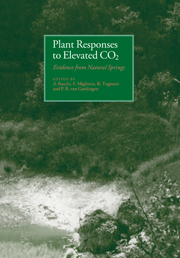Book contents
- Frontmatter
- Contents
- List of contributors
- Preface
- Sites of naturally elevated carbon dioxide
- Migration in the ground of CO2 and other volatile contaminants. Theory and survey
- Levels of CO2 leakage in relation to geology
- CO2 emission in volcanic areas: case histories and hazards
- Controlled degassing of lakes with high CO2 content in Cameroon: an opportunity for ecosystem CO2-enrichment experiments
- Burning coal seams in southern Utah: a natural system for studies of plant responses to elevated CO2
- Long-term effects of enhanced CO2 concentrations on leaf gas exchange: research opportunities using CO2 springs
- Using Icelandic CO2 springs to understand the long-term effects of elevated atmospheric CO2
- Plant CO2 responses in the long term: plants from CO2 springs in Florida and tombs in Egypt
- Acidophilic grass communities of CO2 springs in central Italy: composition, structure and ecology
- Studying morpho-physiological responses of Scirpus lacustris from naturally CO2-enriched environments
- Carbon physiology of Quercus pubescens Wild, growing at the Bossoleto CO2 spring in central Italy
- Preliminary results on dissolved inorganic 13C and 14C content of a CO2-rich mineral spring of Catalonia (NE Spain) and of plants growing in its surroundings
- The impact of elevated CO2 on the growth of Agrostis canina and Plantago major adapted to contrasting CO2 concentrations
- Stomatal numbers in holm oak (Quercus ilex L.) leaves grown in naturally and artificially CO2-enriched environments
- Effects of CO2 on NH4+ assimilation by Cyanidium caldarium, an acidophilic hot springs and hot soils unicellular alga
- Can rising CO2 alleviate oxidative risk for the plant cell? Testing the hypothesis under natural CO2 enrichment
- Increasing concentrations of atmospheric CO2 and decomposition processes in forest ecosystems
- Index
Preface
Published online by Cambridge University Press: 10 February 2010
- Frontmatter
- Contents
- List of contributors
- Preface
- Sites of naturally elevated carbon dioxide
- Migration in the ground of CO2 and other volatile contaminants. Theory and survey
- Levels of CO2 leakage in relation to geology
- CO2 emission in volcanic areas: case histories and hazards
- Controlled degassing of lakes with high CO2 content in Cameroon: an opportunity for ecosystem CO2-enrichment experiments
- Burning coal seams in southern Utah: a natural system for studies of plant responses to elevated CO2
- Long-term effects of enhanced CO2 concentrations on leaf gas exchange: research opportunities using CO2 springs
- Using Icelandic CO2 springs to understand the long-term effects of elevated atmospheric CO2
- Plant CO2 responses in the long term: plants from CO2 springs in Florida and tombs in Egypt
- Acidophilic grass communities of CO2 springs in central Italy: composition, structure and ecology
- Studying morpho-physiological responses of Scirpus lacustris from naturally CO2-enriched environments
- Carbon physiology of Quercus pubescens Wild, growing at the Bossoleto CO2 spring in central Italy
- Preliminary results on dissolved inorganic 13C and 14C content of a CO2-rich mineral spring of Catalonia (NE Spain) and of plants growing in its surroundings
- The impact of elevated CO2 on the growth of Agrostis canina and Plantago major adapted to contrasting CO2 concentrations
- Stomatal numbers in holm oak (Quercus ilex L.) leaves grown in naturally and artificially CO2-enriched environments
- Effects of CO2 on NH4+ assimilation by Cyanidium caldarium, an acidophilic hot springs and hot soils unicellular alga
- Can rising CO2 alleviate oxidative risk for the plant cell? Testing the hypothesis under natural CO2 enrichment
- Increasing concentrations of atmospheric CO2 and decomposition processes in forest ecosystems
- Index
Summary
There has been substantial discussion by politicians, scientists and the general public about the likely effects of the changing composition of the atmosphere of the Earth. The CO2 concentration of the Earth's atmosphere continues to increase in response to land-use change and the burning of fossil fuels. There is no question that this increase is directly linked to the ever increasing global human population and our demand for energy. This is one of the most easily quantified aspects of global environmental change.
It is well accepted that the enhanced CO2 concentrations associated with global change will directly influence the process of photosynthesis in most species of plants. Early observations suggested that increased rates of photosynthesis would lead to increased growth rates of plants. There was a proliferation of experimental studies investigating the effects of CO2 on plants. As more data were collected these became increasingly difficult to interpret. The majority of studies were conducted under artificial conditions in growth rooms, glasshouses or open-top chambers. The great deficiency of most studies was that vegetation was exposed for relatively short periods of time. There seemed to be no way forward that would permit the study of the longterm effects of exposure of vegetation to enhanced CO2 concentrations.
In the early 1990s a few groups of scientists faced with this problem suggested using sites with naturally enhanced atmospheric levels of CO2 as natural experiments. There followed a number of scientific programmes in several locations around the world where vegetation was exposed to enhanced CO2.
- Type
- Chapter
- Information
- Plant Responses to Elevated CO2Evidence from Natural Springs, pp. xiii - xivPublisher: Cambridge University PressPrint publication year: 1997



